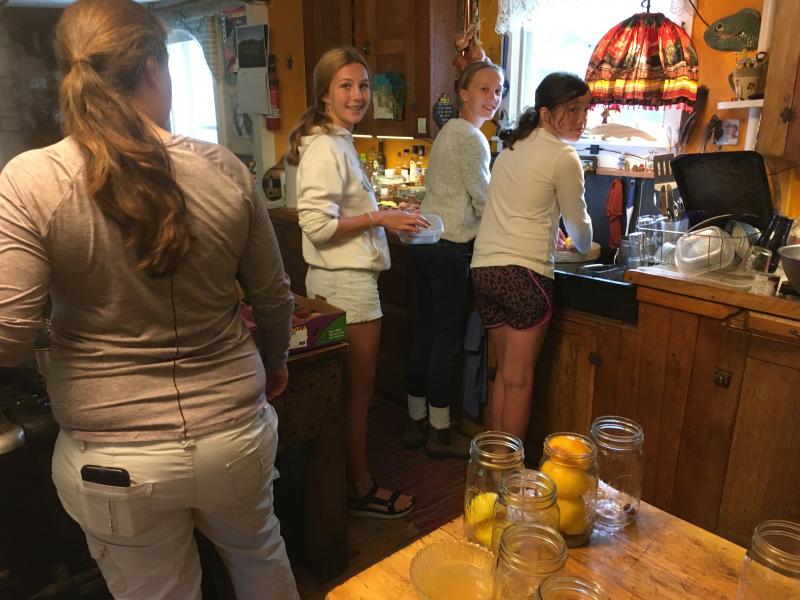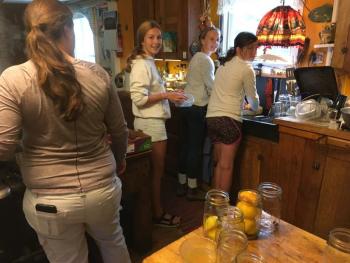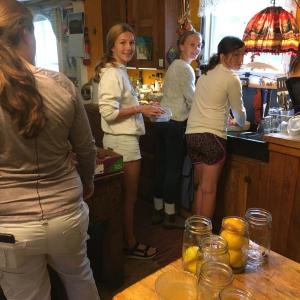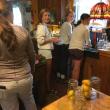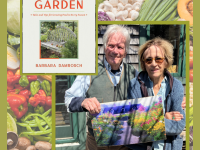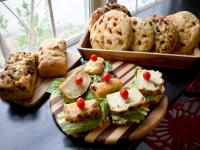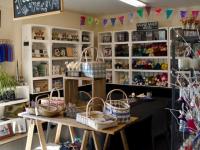This Week in Lincolnville: Putting Food By
Frank and Cyrene Slegona sat together in the chilly fall evenings drying apples for the winter. It was a slow, but simple process, probably too simple for our age of devices we have to endlessly recharge, keeping track of plug-ins, cords, flashing red and green lights.
Frank explained it to me once, as I was munching some of their sweet and chewy dried apple slices. It took a paring knife, a piece of rat wire (that quarter inch screen that is supposed to keep rodents out of things), a couple of bricks and a woodstove. Each night the couple would sit with a basket of their own grown apples between them, peeling, coring and slicing until they had enough slices to cover the wire screen, just the size of the top of their stove and resting on two bricks.
The stove did the rest, simmering and sputtering through the night, the apples a couple of inches above the top, dehydrating in the dry heat. In the morning Cyrene would put them in the freezer in a plastic bag. A few days after our apple conversation Frank stopped by with a wire tray for me. I keep it behind the woodstove, bringing it out in the fall.
CALENDAR
TUESDAY, July 21
Lakes and Ponds Committee, 7 p.m., remote
WEDNESDAY, July 22Library book pickup, 3-6 p.m., Library
SATURDAY, July 25
Library book pickup, 9 a.m.-noon, Library
EVERY WEEK
AA meetings, Tuesdays & Fridays at noon, Norton Pond/Breezemere Bandstand
Lincolnville Community Library, curbside pickup Wednesdays, 3-6 p.m. and Saturdays, 9 a.m.-noon. For information call 706-3896.
Soup Café, cancelled through the pandemic
Schoolhouse Museum open by appointment, 505-5101 or 789-5987
Bayshore Baptist Church, Sunday School for all ages, 9:30 a.m., Worship Service at 11 a.m., Atlantic Highway, in person and streamed on Facebook
United Christian Church, Worship Service 9:30 a.m. via Zoom
Planting, cultivating, weeding, watering are only the first steps in raising your own vegetables. Harvesting, preparing and storing the stuff comes next, just before cooking and eating. Quite a few more steps than a trip to Hannaford’s produce section or the prepared food aisle.
It helps to have a partner.
A basket full of peas, pea pods that is, begs for a spouse or a friend, a glass of ice tea and the back porch. Wally and I spent many hours every summer with that basket, though it often held green beans. Peas, depending on the variety, have to be shelled or snapped, beans are usually snapped, but sometimes shelled.
I’ve managed to snag Don to shell peas with me a time or two this summer, and he tells much the same story, of shelling peas with Jean in the days when they had a big garden.
Wally claimed all the dry beans for himself, though I never argued. He’d sit in the open barn door on bright fall afternoons with a beer and a huge pile of dried up bean pods. Since we never kept track of the varieties, which row were soldier beans, where the Jacobs Cattle were, the pintos, or the black turtles, their pods were all jumbled together at harvest.
He sorted them into three or four bowls as he shucked, country and western playing on the barn radio, a happy man.
Beans and peas are pretty easy once you’ve got them into a manageable size, either shelled or snapped into one-inch pieces. Dump them in a pot of boiling water, a minute or two for beans, less than that for peas, pour through a strainer and then into a bowl of ice water. Strain again and then into the freezer.
I use the gallon size bags and shake out what I need for a meal. The wet peas do freeze together, but I smack the bag on the counter, and they break apart. Beans tend to freeze into a solid mass, so I spread them out first on cookie sheets, freeze, smack the sheets to loosen them, and then into bags.
Canning is another thing altogether. The jars are always down cellar, dusty and spider-webby, the lids buried in the back of a drawer, the kettle out in the barn. The jars and lids have to be sterilized, either boiling empty in the kettle or in the oven or dishwasher (if you have one; I don’t). Peaches and tomatoes are peeled by dipping first in boiling, then ice cold water. All this before you fill your first jar.
June, the oldest of Wally’s three sisters, and the first whom I met, was visiting the summer we moved into this house. I can’t remember where they came from, but I had a lot of peaches, so June and I canned them together. That part I’ve not forgotten, what it was like to have another woman in the kitchen when there were a dozen quart jars in various stages of sterilization, a pot of boiling syrup (to pour over the peaches), another pot boiling to peel them, a huge black kettle of boiling water (the kind that holds nine quart jars) and the water-soaked USDA Extension booklet on canning we were constantly referring to.
Another woman in the kitchen, even one who knew as little as I did about what we were doing, made the whole thing fun. We even had a ghostly visit that afternoon.
This house was well-known around town in those days (the early 70s) for being haunted. Or at any rate, for having ghosts. We’d heard all the stories from the previous owners, the doors that opened by themselves, the rocker that rocked by itself, the car that pulled in the driveway and the shed door that slid open. (Still in the future would be the piano that played, the flicker of movement up the stairs, the middle-of-the-night sense of not being alone, etc.) It was our first summer here, and we were on the lookout.
Then we heard it, June and I. A car door slammed and the sound of the shed door sliding open.
“Did you hear something?” she said.
We looked outside. No one there, no strange car, the shed door as we’d last left it.
It was the first and last time it happened, though it had apparently been a common occurrence with the former owners. So much so that a Rockport police officer, a friend of the couple, claimed to have heard it too. It seems there were several people around town who had too.
After that summer I was pretty much a solo canner, juggling all that boiling water, glass jars and slippery fruit and tomatoes on my own. Margaret Page, my good friend who lived at the Trap, was on her own, as well. For several years we traded an enormous beast of a pressure canner back and forth between our houses. With half-inch thick walls, and huge bolts to fasten down the lid it was a prehistoric relic. She’d found it at a yard sale – I think we split the $10 cost – and finally got tired of lugging it and donated it to the Schoolhouse Museum.
You can still see it there.
After a day of jelly-making (another messy, sticky job) or tomato sauce canning or bread and butter pickles, we’d line the jars up on our respective counters, hoping the other would stop by (as we often did in those days), and pretend to the other “Oh, I’d been meaning to put those in the pantry” just to see the look of envy on the other’s face.
Competitive canning. Can’t beat it.
The only thing that would have been better was if we’d joined forces and done it together. I can’t think why we didn’t, and wish, now that my dear friend has been gone for several years, that we had.
But now I live in a multi-generational house, including two other females. And just down the road live three more I’m related to, four granddaughters in all and a daughter-in-law. I’m a lucky woman.
As mother of three sons I’d certainly counted myself lucky, but living with four males does have its challenges. As does the estrogen-fueled household with all daughters.
The other day the fifteen-year-old asked if I’d teach her how to can peaches. Just imagine!
Hannaford had some nice Georgia peaches in, so I stopped by early one morning and bought two cases. The girls gathered, two from upstairs, two from down the road, and we got to work. It turned out to be a snap; a couple of hours later we had row upon row of glistening jars of perfect peaches, turned upside down on the counter while we waited for that sharp *click!* of a jar lid sealing.
I wish Margaret could have stopped by to admire them with me.
By the way, the Camden Seventh Day Adventist Church has peaches again this summer. $35 for a 38 pound box. Order them by text 207-975-4700 or email.
Town Meeting
Our virtual Town Meeting last week, once the highlight of the town’s year as it brought everyone out on a cold March day for a dinner of baked beans, homemade pie and some often rowdy discussions of town issues, passed practically unnoticed.
We have a new Selectman, Mike Ray, and Josh Gerritsen re-elected, joining the five-person board, as well as two new School Committee members: Tracee O’Brien and John Williams. The biggest issue facing either board this summer, seems to me, to be figuring out how to safely re-open school.
A couple of significant issues were voted on, either by mail-in, absentee ballots or in person at the polls. One approved the land swap that trades town-owned acreage on the Ducktrap River for a four-acre parcel of park on the shore. The town seems to have scored a lovely new spot for us to congregate, picnic, and enjoy the Bay.
The other vote wasn’t so fortunate. Its passage allows the Selectmen to sell the old Beach Schoolhouse at 33 Beach Road, putting in jeopardy two venerable community organizations: the Lincolnville Improvement Association and the Schoolhouse Museum/Historical Society.
A flurry of LBB posts appear to indicate that some voters either didn’t realize what “33 Beach Road” was, (though the article clearly spelled it out), or they hadn’t realized the implication, especially for the town’s historical archive and Improvement Association. With so much apparent interest in finding a solution to our potentially homeless archive and collection, a public (outdoor) meeting to brainstorm ideas for how best to solve the problem will be held Saturday, August 1 at 11 a.m. Anyone in town who is interested in the future of the Lincolnville Historical Society and the Lincolnville Improvement Association is invited to bring a lawn chair and join us at the Breezemere Bandstand for a socially-distanced meeting where everyone will have a chance to throw out ideas. Pass the word, the more the merrier.
Event Date
Address
United States

